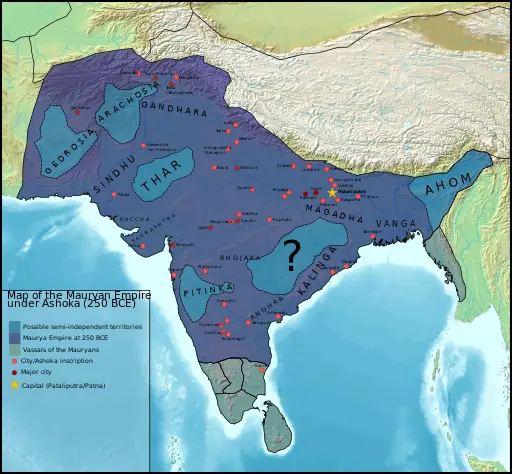Ancient India refers to the Indian subcontinent from prehistoric times to the start of Medieval India
The following is a brief outline of ancient India:
- Pre-history (Neolithic Age) (c. 8000–3500 BCE): This period includes the Bhirrana culture (7570–6200 BCE) and the Mehrgarh culture (7000–2500 BCE).
- Bronze Age India (c. 3500–1750 BCE): This period includes the Indus Valley Civilisation (3300–1300 BCE), Ahar–Banas culture (3000–1500 BCE), Ochre Coloured Pottery culture (2600–1200 BCE), and Cemetery H culture (1900–1300 BCE).
- Iron Age (c. 1750–345 BCE): This period includes the Vedic civilization (1500–600 BCE), Black and red ware culture (1450–700 BCE), Northern Black Polished Ware (1200–500 BCE), and Painted Grey Ware culture (1200 or 700–300 BCE).
- Classical Age (c. 250–500 CE): This period includes the Gupta Empire (320–650 CE), Later Gupta dynasty (490–750 CE), Vakataka Empire (250–500 CE), Pallava Empire (275–901 CE), Kadamba dynasty (345–1347 CE), Western Ganga dynasty (350–1024 CE), and Vishnukundina Empire (420–624 CE).
Please note that this is just an overview, and there is much more to explore about ancient India.
The borders of Ancient India varied over time, but the approximate borders were:
- To the north: the Himalayas
- To the west: the Arabian Sea
- To the east: the Bay of Bengal
- To the south: the Indian Ocean
This includes the modern-day countries of India, Pakistan, Bangladesh, Nepal, and Sri Lanka.
However, it is important to note that Ancient India was not a single, unified state. It was a region made up of many different kingdoms and empires, each with its own borders. For example, the Maurya Empire (322-185 BCE) controlled much of the Indian subcontinent, while the Gupta Empire (320-550 CE) controlled a smaller region in North India.
The borders of Ancient India were also constantly changing due to war, conquest, and migration. For example, migration brought new people and cultures to the Indian subcontinent, and the Persian invasions of the 6th century BCE expanded the borders of the Achaemenid Empire to include parts of Northwest India.
Despite the fluidity of its borders, Ancient India was a region with a rich and diverse culture.
It was the birthplace of Hinduism, Buddhism, and Jainism, and its contributions to science, mathematics, and literature have had a profound impact on the world.
Image credit:
Scratchinghead, CC BY-SA 4.0, via Wikimedia Commons